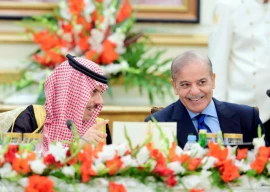
RAWALPINDI:
The Nirankari sect’s place of worship, sanctified because this is where the first marriage according to the Sikh religious traditions was solemnised, still stands with grandeur and past glory.
The historic Sikh temple carries a stock of stories bespeaking reverence drenched in a romance of faith.
Birthplace of the Nirankari sect of Sikhism, it was constructed by Bhai Dayal Singh, a reformist during the era of Maharaja Ranjit Singh and is located in the bustling Nirankari Bazaar, Rawalpindi.
The Gurdwara attracts hundreds of Nirankaris every year from Amritsar, India who visit to pay their respects to the birthplace of their beliefs.

The gurdwara currently functions as the Government Shimla Islamia High School. PHOTOS: MUHAMMAD JAVAID/EXPRESS
“Due to regular recitation [of a hymn] by Diyal Singh [known] as ‘Dhan Narankar’, the Gurdwara and even the market were named Nirankari Gurdwara and Nirankari Market,” said Iqbal Qaiser, author of Historical Sikh Shrines in Pakistan.
The gurdwara currently functions as a school called Government Shimla Islamia High School.
The white marble clad building comprises several, almost crumbling small rooms, once a three-storey hall and a Samadhi. The third floor of the hall collapsed in the earthquake in 2005.
The room where Guru Granth Sahib used to be kept is now the principal’s room. Inside the room, there are white marble plaques carrying inscriptions in Gurmukhi. Above the inscriptions from Granth Sahib, the school administration has written Quranic verses.
A small plaque, according to school Principal Qazi Sanuallah, carries the names of those who made donations for the gurdwara. Compared with temples and other historic buildings in the city, the gurdwara is relatively in good condition and is properly taken care of by the school administration.
“Nirankaris who often visit, thank us for taking care of their place of worship,” Sanaullah said.
Rooted in history
The building was constructed by a reformist, Bhai Dayal Singh, who was born in 1783. He would recite ‘Dhan Narankar’, which translates to “Creator of everything is great”.

The gurdwara currently functions as the Government Shimla Islamia High School. PHOTOS: MUHAMMAD JAVAID/EXPRESS
Qaiser said that before 1851, Sikhs would solemnise marriages according to Hindu customs. “The first marriage held according to Sikh rituals was of Bhai Bhola Singh and Nihal Kaur,” he said.
An offshoot of the sect, led by Bhota Singh who was a disciple of Dayal Singh, emerged in Murree. “Baba Dayal evicted Bhota after he was found drunk inside the Gurdwara. He then moved to Murree and constructed a gurdwara on the same patterns there,” informed Qaiser.
After the death of Dayal, Awtar Singh, a resident of Peshawar and Bhota’s disciple, claimed to be the living guru. “Sikhs regard Guru Granth as the living guru and there is no physical living guru,” said Qaiser. People started worshiping him, causing a split among the Sikhs and Nirankaris. Sikhs would call Nirankaris fake.
After partition, the Nirankaris migrated to Amritsar and built a gurdwara there. On April 13 1978, Nirankaris organised a gathering in which a large number of people converted to the faith, Qaiser said.
The difference in beliefs resulted in clashes among Sikhs and Nirankaris causing deaths of 11 Sikhs.
“To avenge the murder of the Sikhs, Jernail Singh Bhindranwale demanded of the Indian government to officially declare Nirankaris as fake Sikhs,” Qaiser said.

The gurdwara currently functions as the Government Shimla Islamia High School. PHOTOS: MUHAMMAD JAVAID/EXPRESS
After the Indian government refused to accept this, Bhindranwale demanded a separate homeland for Sikhs and started an armed struggle called the Khalistan movement. The movement came to an end with a military operation inside the Golden Temple in Amritsar.
Published in The Express Tribune, February 9th, 2015.





























































COMMENTS
Comments are moderated and generally will be posted if they are on-topic and not abusive.
For more information, please see our Comments FAQ